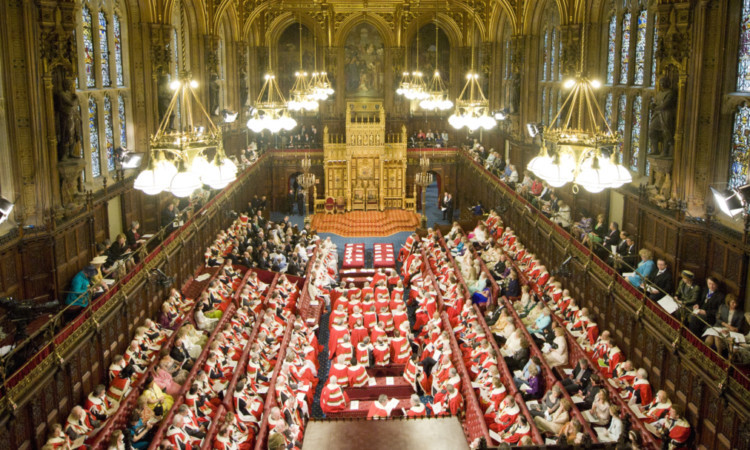A former Scottish Secretary has called for a senior judge to lead a committee examining the “nonsense” blueprint for independence put forward by the Scottish Government.
Lord Forsyth of Drumlean made his call as he launched a stinging attack on the 670-page white paper published by First Minister Alex Salmond last week.
The Conservative peer said the prospectus for the “Balkanisation of Britain” had “all the deliverability and relevance of a letter to Santa Claus”.
Opening a House of Lords debate on the white paper, he said: “As a business plan for the next 300 years for an independent Scotland it has about as much credibility that I think if it were put forward to the Dragons’ Den it wouldn’t even get up the stairs to be filmed in front of them.
“We were told it was going to answer all the central questions about Scottish independence, but in fact it ignores all of the central questions by simply asserting answers that the Scottish Government would like.”
He told Advocate General for Scotland Lord Wallace of Tankerness, answering the debate for the Government: “I would like to suggest that you might consider persuading your colleagues to set up a joint committee of both Houses, perhaps chaired by someone with impeccable credentials – perhaps one of the former law lords – to look at this white paper and go through it.
“It won’t take them long, although it will take them a long time to read it.”
He said the committee should set out “what the consequences will be for both sides of the border”.
“This is not a Scottish issue – this is an issue for every part of the United Kingdom,” he said.
Lord Forsyth said part of the white paper set out what the implications of independence would be if the SNP was elected at the first elections after independence.
“What on earth are civil servants doing writing this stuff and the Government of Scotland putting the bill on the taxpayers for what is an SNP manifesto?” he asked
He said the Permanent Secretary at the Scottish Office should examine the white paper and if he decided it was party political the bill for it should be “sent to the SNP”.
“I don’t see why my taxes should pay for this sort of nonsense,” he said.
Lord Forsyth said Mr Salmond, his deputy Nicola Sturgeon and finance minister John Swinney reminded him of the Road-Song of the Bandar-Log from The Jungle Book about three monkeys
Reciting the lines to peers, he said: “Here we sit in a branchy row, thinking of beautiful things we know; dreaming of deeds that we mean to do, all complete in a minute or two – something noble and grand and good, done by merely wishing we could.”‘Mad Hatter’Labour former minister and MSP Lord Foulkes of Cumnock said Mr Salmond did not have the power to implement the proposals he was putting forward.
He told peers: “He reminds me of the Mad Hatter in Alice In Wonderland because if he says it so, it must be so.”
Liberal Democrat Lord Steel of Aikwood, a former presiding officer of the Scottish Parliament, said the white paper was “wishful thinking”.
He said: “It spells out what the SNP would like to happen, not what actually will happen and there is a fundamental difference between the two.”
Constitutional historian Lord Hennessy of Nympsfield, an independent crossbench peer, questioned what would happen if the Scots voted to stay part of the Union, but the UK as a whole then voted to leave the EU.
He said if a majority of Scottish voters had voted in favour of staying in the EU, they would say the 2014 deal was off.
“Could a UK government then deny Edinburgh another agreement and another referendum in, say, 2020?” he asked.
He added: “I think there is more uncertainty imperilling our islands in peacetime than at any time in living memory – and far more than our people realise.”
Scottish Advocate General Lord Wallace of Tankerness agreed to look into calls for a joint committee with government business managers, insisting it could only be established with the agreement of both Houses.
Lord Wallace said the white paper contained “fundamental misunderstandings” and was strong on assertion while being short on argument.
He said Scotland would be a new state after independence. “It would have to enter into a whole series of negotiations, including seeking membership of Nato and the EU.”
Accusing the SNP of “ducking” serious questions about independence, Lord Wallace said Scottish people were not being given proper information to make up their minds.
In looking to the future it was important to remember the strengths of the United Kingdom, he added.Lords ‘a democratic absurdity’Annabelle Ewing, an SNP MSP who sits on the Scottish Parliament’s Referendum Bill Committee, said later: “The spectacle of a bunch of unelected Lords lecturing people in Scotland about our democratic future – and in such immature terms – simply underlines the broken nature of the Westminster system.
“Lord Forsyth and his ilk are walking advertisements of the need for a Yes vote and an independent Scotland.
“The UK has far more unelected Lords with the power to pass laws than there are elected MPs, which is a democratic absurdity, and people in Scotland only get to elect some 4% of the parliamentarians at Westminster.
“The compelling case for a Yes vote is that the people of Scotland will elect 100% of the men and women deciding laws and policies for Scotland, and we get the government we vote for 100% of the time, not just occasionally.
“That is the kind of grown-up debate we are having in Scotland, while unelected Tory, Labour and Lib Dem Lords waste taxpayers’ money debating which of them dislikes Scotland’s democratically-elected and popular SNP Government the most.”
